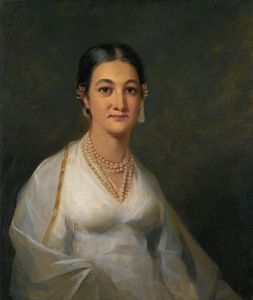
Portrait of a Young Woman
A hand-painted replica of Rembrandt van Rijn’s masterpiece Portrait of a Young Woman, meticulously crafted by professional artists to capture the true essence of the original. Each piece is created with museum-quality canvas and rare mineral pigments, carefully painted by experienced artists with delicate brushstrokes and rich, layered colors to perfectly recreate the texture of the original artwork. Unlike machine-printed reproductions, this hand-painted version brings the painting to life, infused with the artist’s emotions and skill in every stroke. Whether for personal collection or home decoration, it instantly elevates the artistic atmosphere of any space.
"Portrait of a Young Woman" is an oil painting by the renowned Dutch artist Rembrandt van Rijn, created in 1632. This work is a testament to Rembrandt's mastery in portraiture, showcasing his ability to capture the essence and character of his subjects with remarkable depth and realism. The painting is part of the collection at the Mauritshuis in The Hague, Netherlands, a museum known for its impressive array of Dutch Golden Age paintings.
The portrait features a young woman, whose identity remains unknown, depicted with a serene and contemplative expression. Rembrandt's skillful use of light and shadow, a technique known as chiaroscuro, is evident in this work. This method not only highlights the woman's facial features but also adds a three-dimensional quality to the painting, bringing the subject to life. The soft illumination on her face contrasts with the darker background, drawing the viewer's attention to her gentle gaze and the subtle details of her attire.
The young woman is dressed in a modest yet elegant manner, typical of the fashion of the early 17th century in the Netherlands. Her attire includes a dark dress with a broad, white lace collar and a matching lace cap, which frames her face delicately. The lacework is rendered with meticulous attention to detail, showcasing Rembrandt's ability to depict intricate textures and materials with precision.
Rembrandt's portraits are celebrated for their psychological depth, and "Portrait of a Young Woman" is no exception. The artist's focus on the inner life of his subjects is evident in the woman's introspective expression, inviting viewers to ponder her thoughts and emotions. This quality is a hallmark of Rembrandt's work, setting him apart from many of his contemporaries.
The painting was created during a particularly successful period in Rembrandt's career. In 1632, he had recently moved to Amsterdam, where he quickly gained a reputation as a leading portraitist. This era marked the beginning of his rise to prominence, attracting wealthy patrons and commissions from across the Dutch Republic. "Portrait of a Young Woman" reflects the burgeoning confidence and technical prowess that characterized Rembrandt's work during this time.
While the identity of the young woman remains a mystery, the painting itself has been the subject of scholarly interest and admiration. It exemplifies Rembrandt's innovative approach to portraiture, which combined a keen observation of human nature with a masterful command of paint and composition. The work continues to be studied and appreciated for its artistic and historical significance, offering insights into the cultural and social milieu of the Dutch Golden Age.
In summary, "Portrait of a Young Woman" is a quintessential example of Rembrandt's portraiture, highlighting his exceptional ability to convey the complexity of human emotion and character. The painting remains a cherished piece within the Mauritshuis collection, admired by art enthusiasts and scholars alike for its timeless beauty and profound expressiveness.


















